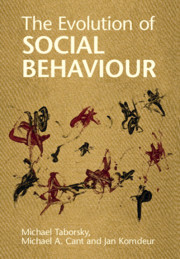Crossref Citations
This Book has been
cited by the following publications. This list is generated based on data provided by Crossref.
Paulsson, Niklas I.
and
Taborsky, Michael
2021.
Reaching Out for Inaccessible Food Is a Potential Begging Signal in Cooperating Wild-Type Norway Rats, Rattus norvegicus.
Frontiers in Psychology,
Vol. 12,
Issue. ,
Komdeur, Jan
and
Ma, Long
2021.
Keeping up with environmental change: The importance of sociality.
Ethology,
Vol. 127,
Issue. 10,
p.
790.
Taborsky, Barbara
2021.
The Evolution of Social Behaviour.
Ethology,
Vol. 127,
Issue. 10,
p.
751.
Taborsky, Barbara
and
Bshary, Redouan
2021.
A positive feedback loop between sociality and social competence.
Ethology,
Vol. 127,
Issue. 10,
p.
774.
Melgar, Julian
Schou, Mads F
Bonato, Maud
Brand, Zanell
Engelbrecht, Anel
Cloete, Schalk WP
and
Cornwallis, Charlie K
2022.
Experimental evidence that group size generates divergent benefits of cooperative breeding for male and female ostriches.
eLife,
Vol. 11,
Issue. ,
Smith, Maria G.
and
Riehl, Christina
2022.
Workload Distribution and Division of Labor in Cooperative Societies.
The Quarterly Review of Biology,
Vol. 97,
Issue. 3,
p.
183.
Everth, Thomas
and
Gurney, Laura
2022.
Emergent Realities: Diffracting Barad within a quantum-realist ontology of matter and politics.
European Journal for Philosophy of Science,
Vol. 12,
Issue. 3,
García-Ruiz, Irene
and
Taborsky, Michael
2022.
Group augmentation on trial: helpers in small groups enhance antipredator defence of eggs.
Biology Letters,
Vol. 18,
Issue. 10,
Yu, Chia-Ning
Kuo, Chi-Yun
Lin, Hsing-Chieh
and
Su, Yong-Chao
2022.
Foraging Payoffs Change With Group Size in Kin and Non-kin Groups of an Argyrodinae Kleptoparasitic Spider, Argyrodes miniaceus.
Frontiers in Ecology and Evolution,
Vol. 10,
Issue. ,
Edgerly, Janice S.
2022.
Dispersal Risks and Decisions Shape How Non-kin Groups Form in a Tropical Silk-Sharing Webspinner (Insecta: Embioptera).
Frontiers in Ecology and Evolution,
Vol. 10,
Issue. ,
Paulsson, Niklas Ingvar
and
Taborsky, Michael
2022.
Norway rats help social partners in need in response to ultrasonic begging signals.
Ethology,
Vol. 128,
Issue. 12,
p.
724.
García-Ruiz, Irene
Quiñones, Andrés
and
Taborsky, Michael
2022.
The evolution of cooperative breeding by direct and indirect fitness effects.
Science Advances,
Vol. 8,
Issue. 21,
Ma, Long
Versteegh, Maaike A.
Hammers, Martijn
and
Komdeur, Jan
2022.
Sex-specific influence of communal breeding experience on parenting performance and fitness in a burying beetle.
Royal Society Open Science,
Vol. 9,
Issue. 2,
Kanwal, Jasmeen
and
Gardner, Andy
2022.
Population viscosity promotes altruism under density-dependent dispersal.
Proceedings of the Royal Society B: Biological Sciences,
Vol. 289,
Issue. 1970,
Gillett, Grant
and
Glannon, Walter
2023.
The Neurodynamic Soul.
p.
163.
Nonacs, Peter
2023.
Why do Hymenopteran workers drift to non-natal groups? Generalized reciprocity and the maximization of group and parental success.
Journal of Evolutionary Biology,
Vol. 36,
Issue. 10,
p.
1365.
Enghelhardt, Sacha C.
Paulsson, Niklas I.
and
Taborsky, Michael
2023.
Assessment of help value affects reciprocation in Norway rats.
Royal Society Open Science,
Vol. 10,
Issue. 10,
Green, Jonathan P.
Franco, Catarina
Davidson, Amanda J.
Lee, Vicki
Stockley, Paula
Beynon, Robert J.
and
Hurst, Jane L.
2023.
Cryptic kin discrimination during communal lactation in mice favours cooperation between relatives.
Communications Biology,
Vol. 6,
Issue. 1,
Zöttl, Markus
Schreier, Tanja
Taborsky, Michael
and
Ridley, Amanda
2023.
Coercion promotes alloparental care in cooperative breeders.
Behavioral Ecology,
Vol. 34,
Issue. 3,
p.
363.
Twyman, Kalyani Z.
and
Gardner, Andy
2023.
Kin selection of time travel: the social evolutionary causes and consequences of dormancy.
Proceedings of the Royal Society B: Biological Sciences,
Vol. 290,
Issue. 2006,





